Corporate Governance Failure and Implications in Healthcare Report
VerifiedAdded on 2019/11/26
|6
|1329
|429
Report
AI Summary
This report examines the corporate governance failures at Bundaberg Hospital, focusing on the negligence in the appointment and oversight of Dr. Jayant Patel. The inquiry revealed failures in credentialing, assessment of competency, and investigation of complaints, leading to patient deaths. The report highlights the importance of organizational culture and ethical values in decision-making to prevent such failures. It emphasizes the need for value congruence between individual and organizational ethics, suggesting improvements to the hospital's governance mechanisms. The conclusion underscores the impact of administrative negligence on clinical governance and patient outcomes, advocating for a strong focus on ethical practices and robust governance structures to ensure quality healthcare. The report also provides recommendations to improve organizational culture and decision making processes to avoid similar failures in the future.
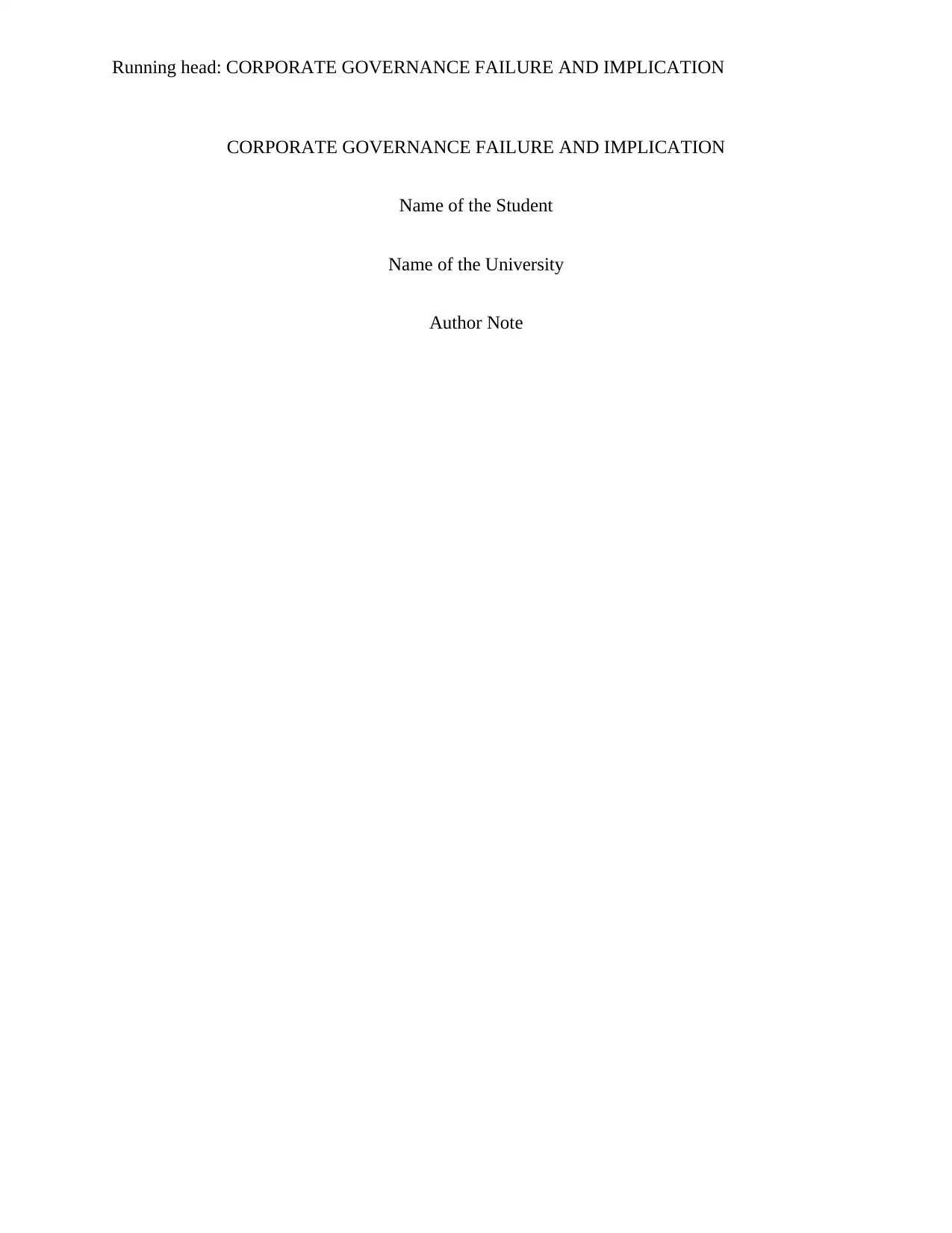
Running head: CORPORATE GOVERNANCE FAILURE AND IMPLICATION
CORPORATE GOVERNANCE FAILURE AND IMPLICATION
Name of the Student
Name of the University
Author Note
CORPORATE GOVERNANCE FAILURE AND IMPLICATION
Name of the Student
Name of the University
Author Note
Paraphrase This Document
Need a fresh take? Get an instant paraphrase of this document with our AI Paraphraser
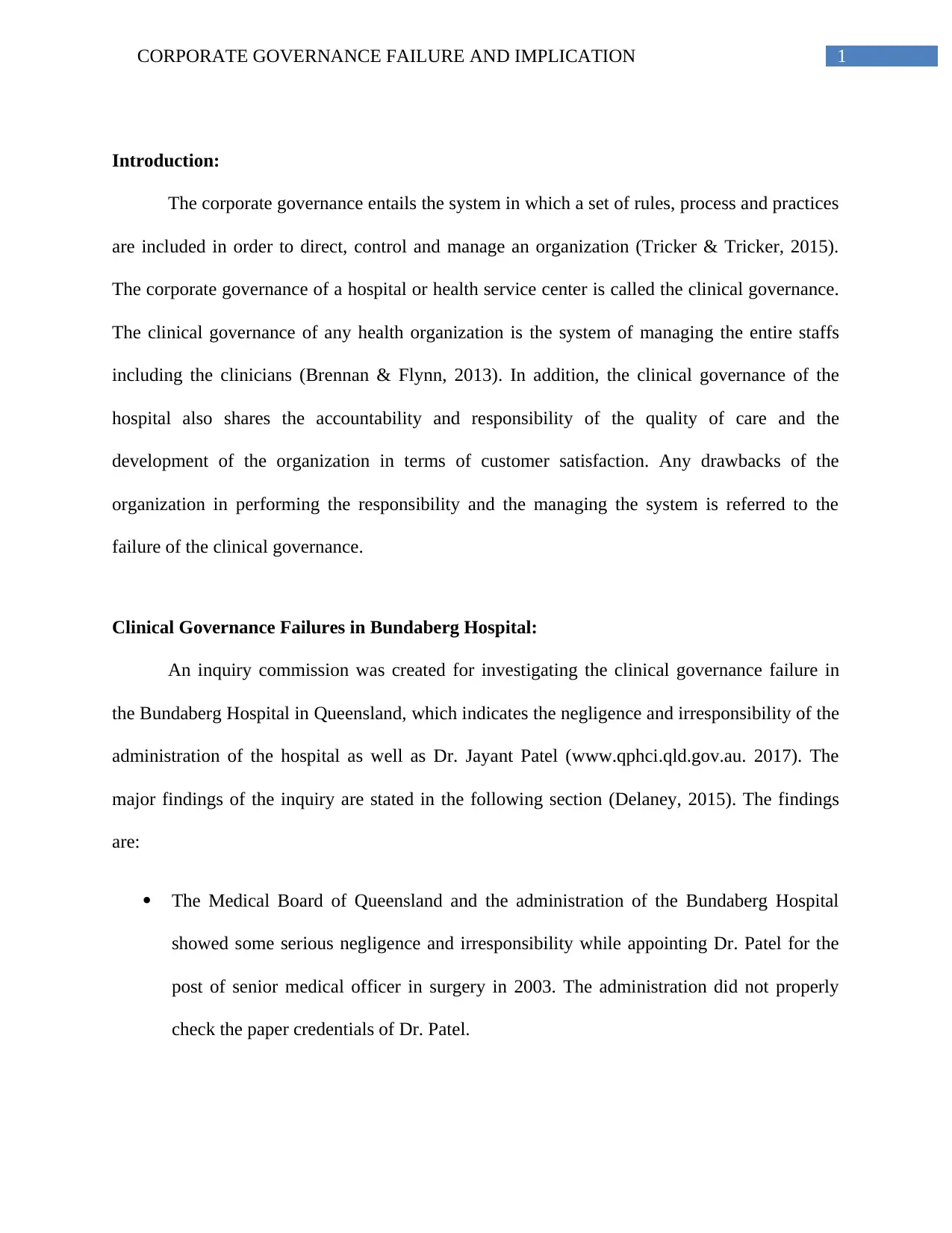
1CORPORATE GOVERNANCE FAILURE AND IMPLICATION
Introduction:
The corporate governance entails the system in which a set of rules, process and practices
are included in order to direct, control and manage an organization (Tricker & Tricker, 2015).
The corporate governance of a hospital or health service center is called the clinical governance.
The clinical governance of any health organization is the system of managing the entire staffs
including the clinicians (Brennan & Flynn, 2013). In addition, the clinical governance of the
hospital also shares the accountability and responsibility of the quality of care and the
development of the organization in terms of customer satisfaction. Any drawbacks of the
organization in performing the responsibility and the managing the system is referred to the
failure of the clinical governance.
Clinical Governance Failures in Bundaberg Hospital:
An inquiry commission was created for investigating the clinical governance failure in
the Bundaberg Hospital in Queensland, which indicates the negligence and irresponsibility of the
administration of the hospital as well as Dr. Jayant Patel (www.qphci.qld.gov.au. 2017). The
major findings of the inquiry are stated in the following section (Delaney, 2015). The findings
are:
The Medical Board of Queensland and the administration of the Bundaberg Hospital
showed some serious negligence and irresponsibility while appointing Dr. Patel for the
post of senior medical officer in surgery in 2003. The administration did not properly
check the paper credentials of Dr. Patel.
Introduction:
The corporate governance entails the system in which a set of rules, process and practices
are included in order to direct, control and manage an organization (Tricker & Tricker, 2015).
The corporate governance of a hospital or health service center is called the clinical governance.
The clinical governance of any health organization is the system of managing the entire staffs
including the clinicians (Brennan & Flynn, 2013). In addition, the clinical governance of the
hospital also shares the accountability and responsibility of the quality of care and the
development of the organization in terms of customer satisfaction. Any drawbacks of the
organization in performing the responsibility and the managing the system is referred to the
failure of the clinical governance.
Clinical Governance Failures in Bundaberg Hospital:
An inquiry commission was created for investigating the clinical governance failure in
the Bundaberg Hospital in Queensland, which indicates the negligence and irresponsibility of the
administration of the hospital as well as Dr. Jayant Patel (www.qphci.qld.gov.au. 2017). The
major findings of the inquiry are stated in the following section (Delaney, 2015). The findings
are:
The Medical Board of Queensland and the administration of the Bundaberg Hospital
showed some serious negligence and irresponsibility while appointing Dr. Patel for the
post of senior medical officer in surgery in 2003. The administration did not properly
check the paper credentials of Dr. Patel.
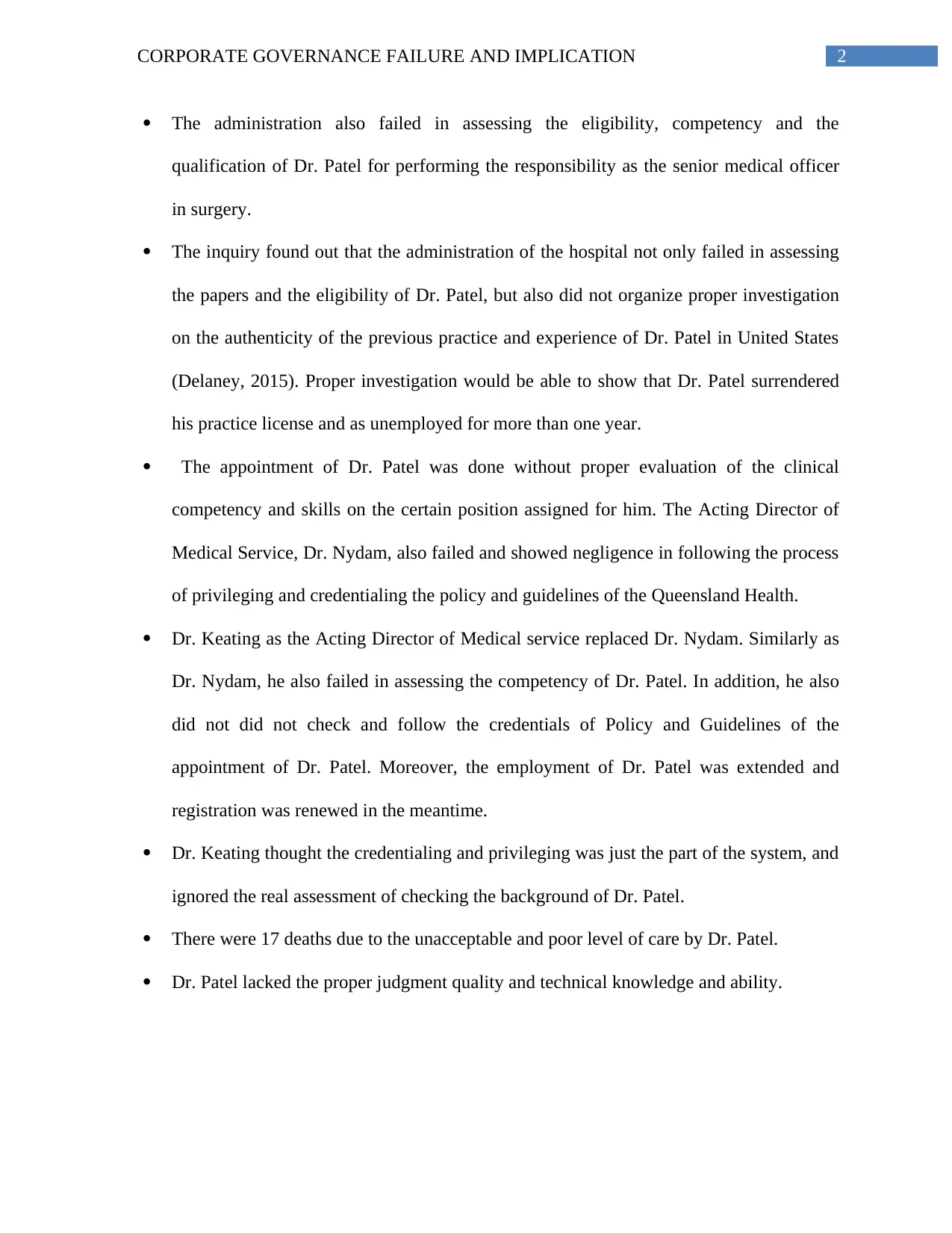
2CORPORATE GOVERNANCE FAILURE AND IMPLICATION
The administration also failed in assessing the eligibility, competency and the
qualification of Dr. Patel for performing the responsibility as the senior medical officer
in surgery.
The inquiry found out that the administration of the hospital not only failed in assessing
the papers and the eligibility of Dr. Patel, but also did not organize proper investigation
on the authenticity of the previous practice and experience of Dr. Patel in United States
(Delaney, 2015). Proper investigation would be able to show that Dr. Patel surrendered
his practice license and as unemployed for more than one year.
The appointment of Dr. Patel was done without proper evaluation of the clinical
competency and skills on the certain position assigned for him. The Acting Director of
Medical Service, Dr. Nydam, also failed and showed negligence in following the process
of privileging and credentialing the policy and guidelines of the Queensland Health.
Dr. Keating as the Acting Director of Medical service replaced Dr. Nydam. Similarly as
Dr. Nydam, he also failed in assessing the competency of Dr. Patel. In addition, he also
did not did not check and follow the credentials of Policy and Guidelines of the
appointment of Dr. Patel. Moreover, the employment of Dr. Patel was extended and
registration was renewed in the meantime.
Dr. Keating thought the credentialing and privileging was just the part of the system, and
ignored the real assessment of checking the background of Dr. Patel.
There were 17 deaths due to the unacceptable and poor level of care by Dr. Patel.
Dr. Patel lacked the proper judgment quality and technical knowledge and ability.
The administration also failed in assessing the eligibility, competency and the
qualification of Dr. Patel for performing the responsibility as the senior medical officer
in surgery.
The inquiry found out that the administration of the hospital not only failed in assessing
the papers and the eligibility of Dr. Patel, but also did not organize proper investigation
on the authenticity of the previous practice and experience of Dr. Patel in United States
(Delaney, 2015). Proper investigation would be able to show that Dr. Patel surrendered
his practice license and as unemployed for more than one year.
The appointment of Dr. Patel was done without proper evaluation of the clinical
competency and skills on the certain position assigned for him. The Acting Director of
Medical Service, Dr. Nydam, also failed and showed negligence in following the process
of privileging and credentialing the policy and guidelines of the Queensland Health.
Dr. Keating as the Acting Director of Medical service replaced Dr. Nydam. Similarly as
Dr. Nydam, he also failed in assessing the competency of Dr. Patel. In addition, he also
did not did not check and follow the credentials of Policy and Guidelines of the
appointment of Dr. Patel. Moreover, the employment of Dr. Patel was extended and
registration was renewed in the meantime.
Dr. Keating thought the credentialing and privileging was just the part of the system, and
ignored the real assessment of checking the background of Dr. Patel.
There were 17 deaths due to the unacceptable and poor level of care by Dr. Patel.
Dr. Patel lacked the proper judgment quality and technical knowledge and ability.
⊘ This is a preview!⊘
Do you want full access?
Subscribe today to unlock all pages.

Trusted by 1+ million students worldwide
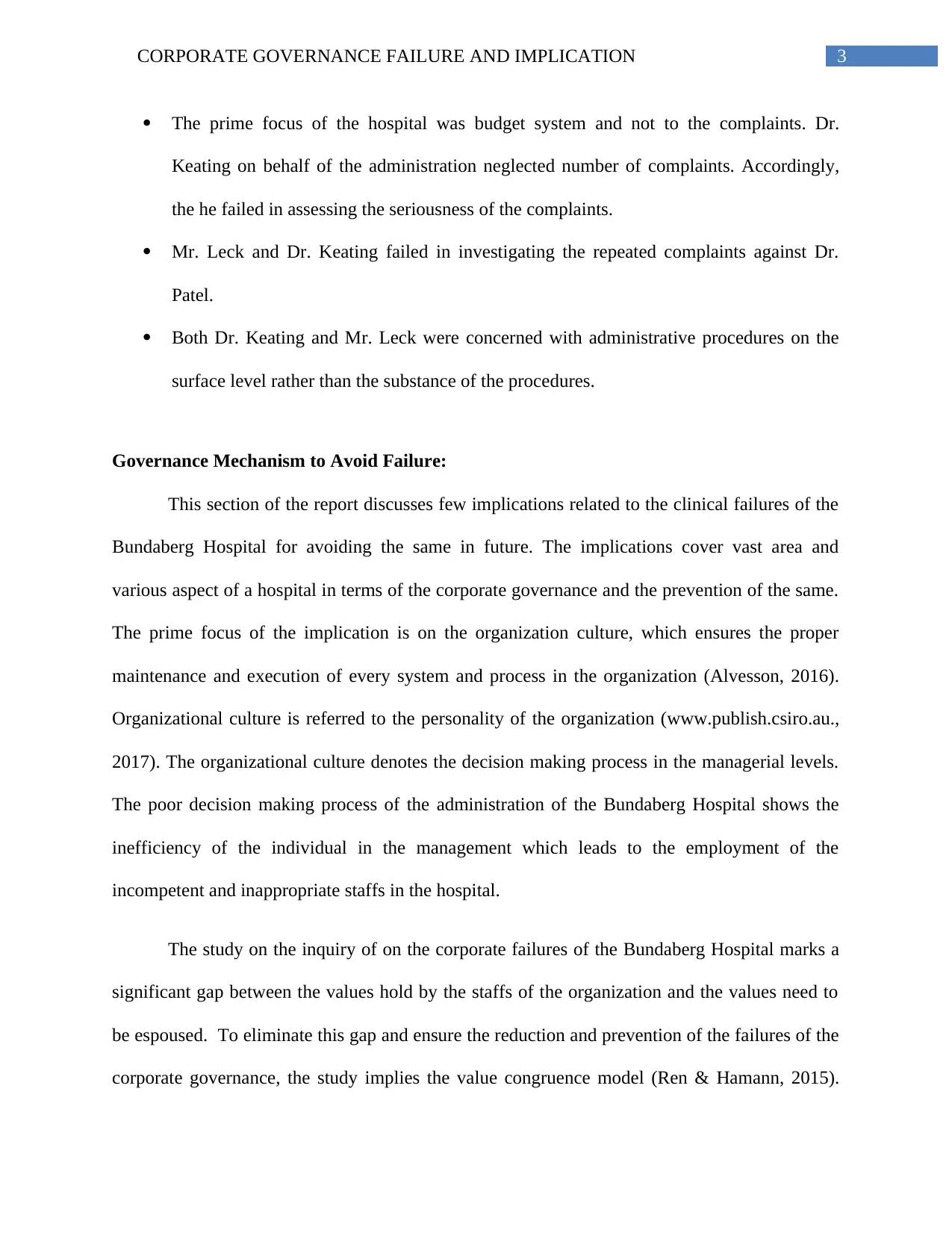
3CORPORATE GOVERNANCE FAILURE AND IMPLICATION
The prime focus of the hospital was budget system and not to the complaints. Dr.
Keating on behalf of the administration neglected number of complaints. Accordingly,
the he failed in assessing the seriousness of the complaints.
Mr. Leck and Dr. Keating failed in investigating the repeated complaints against Dr.
Patel.
Both Dr. Keating and Mr. Leck were concerned with administrative procedures on the
surface level rather than the substance of the procedures.
Governance Mechanism to Avoid Failure:
This section of the report discusses few implications related to the clinical failures of the
Bundaberg Hospital for avoiding the same in future. The implications cover vast area and
various aspect of a hospital in terms of the corporate governance and the prevention of the same.
The prime focus of the implication is on the organization culture, which ensures the proper
maintenance and execution of every system and process in the organization (Alvesson, 2016).
Organizational culture is referred to the personality of the organization (www.publish.csiro.au.,
2017). The organizational culture denotes the decision making process in the managerial levels.
The poor decision making process of the administration of the Bundaberg Hospital shows the
inefficiency of the individual in the management which leads to the employment of the
incompetent and inappropriate staffs in the hospital.
The study on the inquiry of on the corporate failures of the Bundaberg Hospital marks a
significant gap between the values hold by the staffs of the organization and the values need to
be espoused. To eliminate this gap and ensure the reduction and prevention of the failures of the
corporate governance, the study implies the value congruence model (Ren & Hamann, 2015).
The prime focus of the hospital was budget system and not to the complaints. Dr.
Keating on behalf of the administration neglected number of complaints. Accordingly,
the he failed in assessing the seriousness of the complaints.
Mr. Leck and Dr. Keating failed in investigating the repeated complaints against Dr.
Patel.
Both Dr. Keating and Mr. Leck were concerned with administrative procedures on the
surface level rather than the substance of the procedures.
Governance Mechanism to Avoid Failure:
This section of the report discusses few implications related to the clinical failures of the
Bundaberg Hospital for avoiding the same in future. The implications cover vast area and
various aspect of a hospital in terms of the corporate governance and the prevention of the same.
The prime focus of the implication is on the organization culture, which ensures the proper
maintenance and execution of every system and process in the organization (Alvesson, 2016).
Organizational culture is referred to the personality of the organization (www.publish.csiro.au.,
2017). The organizational culture denotes the decision making process in the managerial levels.
The poor decision making process of the administration of the Bundaberg Hospital shows the
inefficiency of the individual in the management which leads to the employment of the
incompetent and inappropriate staffs in the hospital.
The study on the inquiry of on the corporate failures of the Bundaberg Hospital marks a
significant gap between the values hold by the staffs of the organization and the values need to
be espoused. To eliminate this gap and ensure the reduction and prevention of the failures of the
corporate governance, the study implies the value congruence model (Ren & Hamann, 2015).
Paraphrase This Document
Need a fresh take? Get an instant paraphrase of this document with our AI Paraphraser
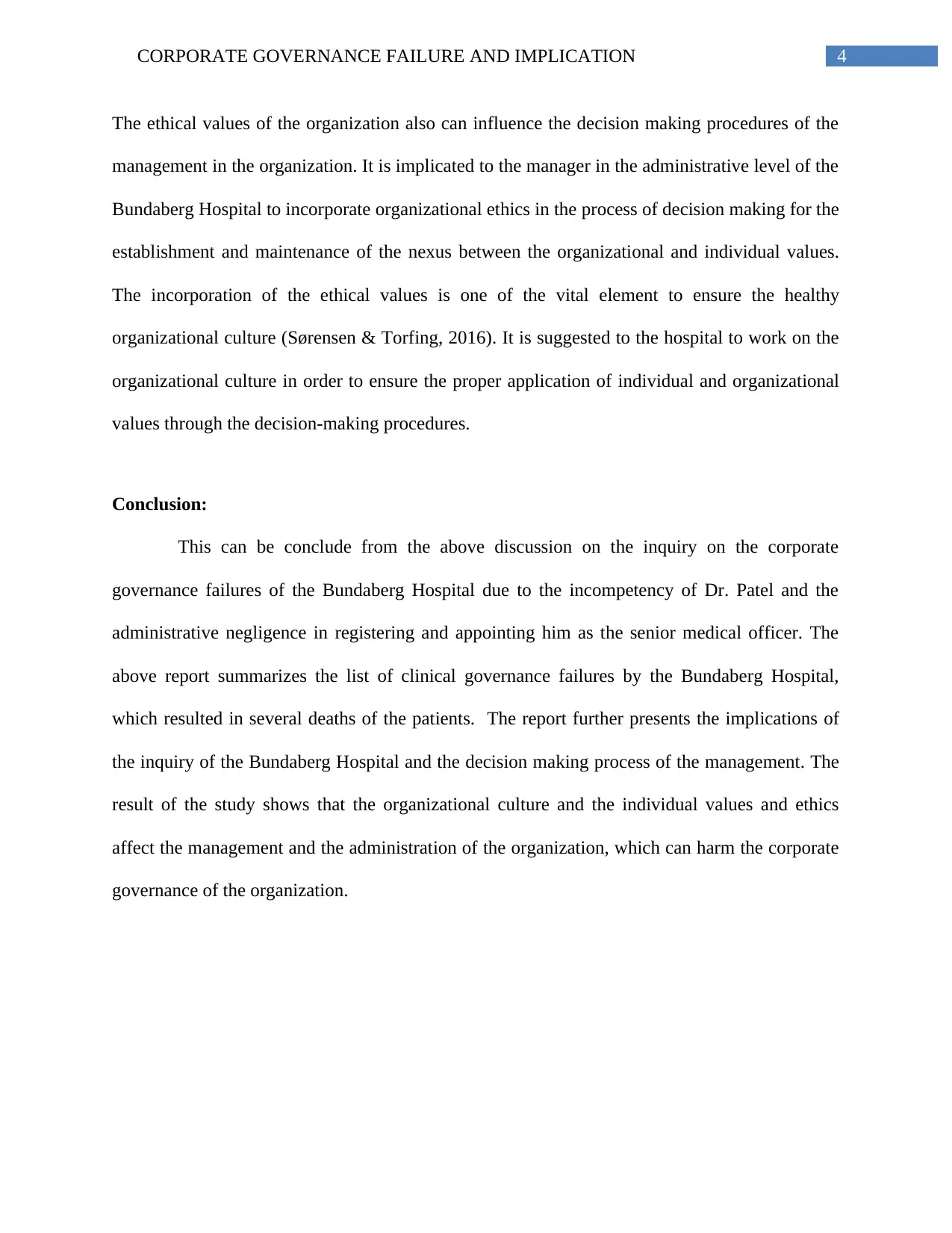
4CORPORATE GOVERNANCE FAILURE AND IMPLICATION
The ethical values of the organization also can influence the decision making procedures of the
management in the organization. It is implicated to the manager in the administrative level of the
Bundaberg Hospital to incorporate organizational ethics in the process of decision making for the
establishment and maintenance of the nexus between the organizational and individual values.
The incorporation of the ethical values is one of the vital element to ensure the healthy
organizational culture (Sørensen & Torfing, 2016). It is suggested to the hospital to work on the
organizational culture in order to ensure the proper application of individual and organizational
values through the decision-making procedures.
Conclusion:
This can be conclude from the above discussion on the inquiry on the corporate
governance failures of the Bundaberg Hospital due to the incompetency of Dr. Patel and the
administrative negligence in registering and appointing him as the senior medical officer. The
above report summarizes the list of clinical governance failures by the Bundaberg Hospital,
which resulted in several deaths of the patients. The report further presents the implications of
the inquiry of the Bundaberg Hospital and the decision making process of the management. The
result of the study shows that the organizational culture and the individual values and ethics
affect the management and the administration of the organization, which can harm the corporate
governance of the organization.
The ethical values of the organization also can influence the decision making procedures of the
management in the organization. It is implicated to the manager in the administrative level of the
Bundaberg Hospital to incorporate organizational ethics in the process of decision making for the
establishment and maintenance of the nexus between the organizational and individual values.
The incorporation of the ethical values is one of the vital element to ensure the healthy
organizational culture (Sørensen & Torfing, 2016). It is suggested to the hospital to work on the
organizational culture in order to ensure the proper application of individual and organizational
values through the decision-making procedures.
Conclusion:
This can be conclude from the above discussion on the inquiry on the corporate
governance failures of the Bundaberg Hospital due to the incompetency of Dr. Patel and the
administrative negligence in registering and appointing him as the senior medical officer. The
above report summarizes the list of clinical governance failures by the Bundaberg Hospital,
which resulted in several deaths of the patients. The report further presents the implications of
the inquiry of the Bundaberg Hospital and the decision making process of the management. The
result of the study shows that the organizational culture and the individual values and ethics
affect the management and the administration of the organization, which can harm the corporate
governance of the organization.
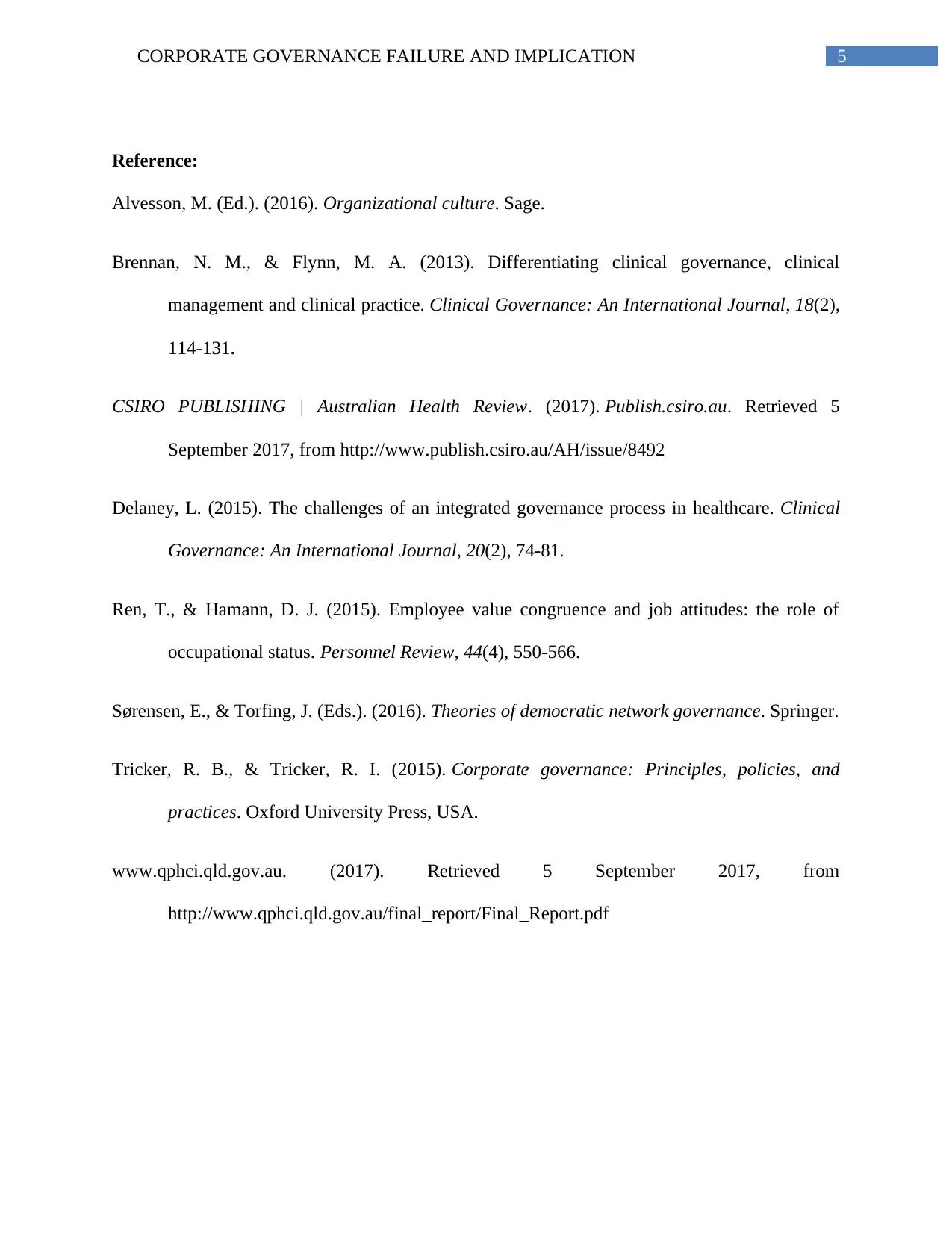
5CORPORATE GOVERNANCE FAILURE AND IMPLICATION
Reference:
Alvesson, M. (Ed.). (2016). Organizational culture. Sage.
Brennan, N. M., & Flynn, M. A. (2013). Differentiating clinical governance, clinical
management and clinical practice. Clinical Governance: An International Journal, 18(2),
114-131.
CSIRO PUBLISHING | Australian Health Review. (2017). Publish.csiro.au. Retrieved 5
September 2017, from http://www.publish.csiro.au/AH/issue/8492
Delaney, L. (2015). The challenges of an integrated governance process in healthcare. Clinical
Governance: An International Journal, 20(2), 74-81.
Ren, T., & Hamann, D. J. (2015). Employee value congruence and job attitudes: the role of
occupational status. Personnel Review, 44(4), 550-566.
Sørensen, E., & Torfing, J. (Eds.). (2016). Theories of democratic network governance. Springer.
Tricker, R. B., & Tricker, R. I. (2015). Corporate governance: Principles, policies, and
practices. Oxford University Press, USA.
www.qphci.qld.gov.au. (2017). Retrieved 5 September 2017, from
http://www.qphci.qld.gov.au/final_report/Final_Report.pdf
Reference:
Alvesson, M. (Ed.). (2016). Organizational culture. Sage.
Brennan, N. M., & Flynn, M. A. (2013). Differentiating clinical governance, clinical
management and clinical practice. Clinical Governance: An International Journal, 18(2),
114-131.
CSIRO PUBLISHING | Australian Health Review. (2017). Publish.csiro.au. Retrieved 5
September 2017, from http://www.publish.csiro.au/AH/issue/8492
Delaney, L. (2015). The challenges of an integrated governance process in healthcare. Clinical
Governance: An International Journal, 20(2), 74-81.
Ren, T., & Hamann, D. J. (2015). Employee value congruence and job attitudes: the role of
occupational status. Personnel Review, 44(4), 550-566.
Sørensen, E., & Torfing, J. (Eds.). (2016). Theories of democratic network governance. Springer.
Tricker, R. B., & Tricker, R. I. (2015). Corporate governance: Principles, policies, and
practices. Oxford University Press, USA.
www.qphci.qld.gov.au. (2017). Retrieved 5 September 2017, from
http://www.qphci.qld.gov.au/final_report/Final_Report.pdf
⊘ This is a preview!⊘
Do you want full access?
Subscribe today to unlock all pages.

Trusted by 1+ million students worldwide
1 out of 6
Related Documents
Your All-in-One AI-Powered Toolkit for Academic Success.
+13062052269
info@desklib.com
Available 24*7 on WhatsApp / Email
![[object Object]](/_next/static/media/star-bottom.7253800d.svg)
Unlock your academic potential
Copyright © 2020–2025 A2Z Services. All Rights Reserved. Developed and managed by ZUCOL.





